Evaluation of Humanitarian Response in Myanmar
VerifiedAdded on 2023/01/03
|18
|4476
|76
AI Summary
This report critically assesses and details the findings and recommendations from an evaluation of Australian humanitarian assistance in Myanmar. It focuses on the relevance, effectiveness, and efficacy of the assistance provided. The evaluation utilized qualitative research methods and data from various sources. The findings highlight the need for continued and systemic humanitarian aid in Myanmar.
Contribute Materials
Your contribution can guide someone’s learning journey. Share your
documents today.
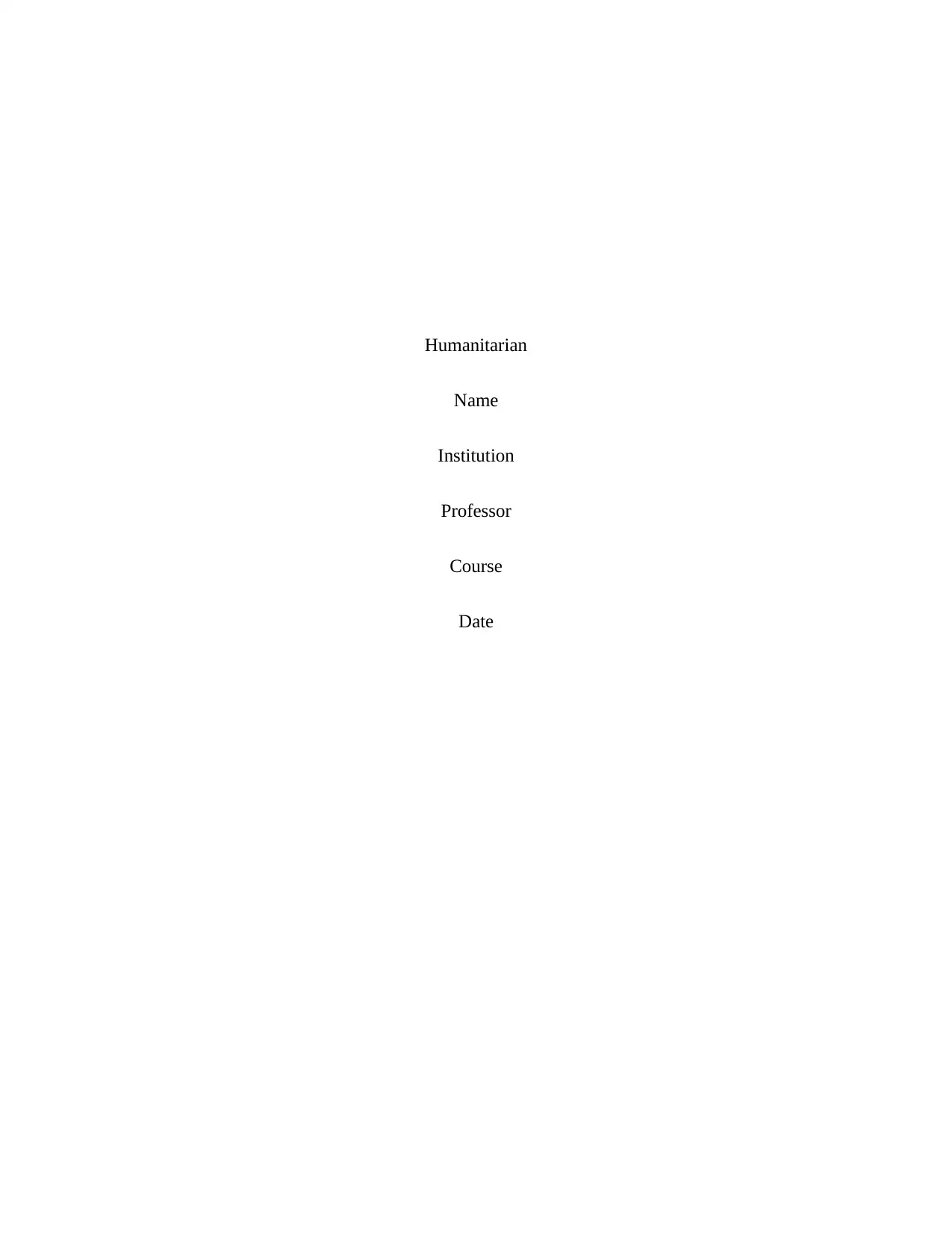
Humanitarian
Name
Institution
Professor
Course
Date
Name
Institution
Professor
Course
Date
Secure Best Marks with AI Grader
Need help grading? Try our AI Grader for instant feedback on your assignments.
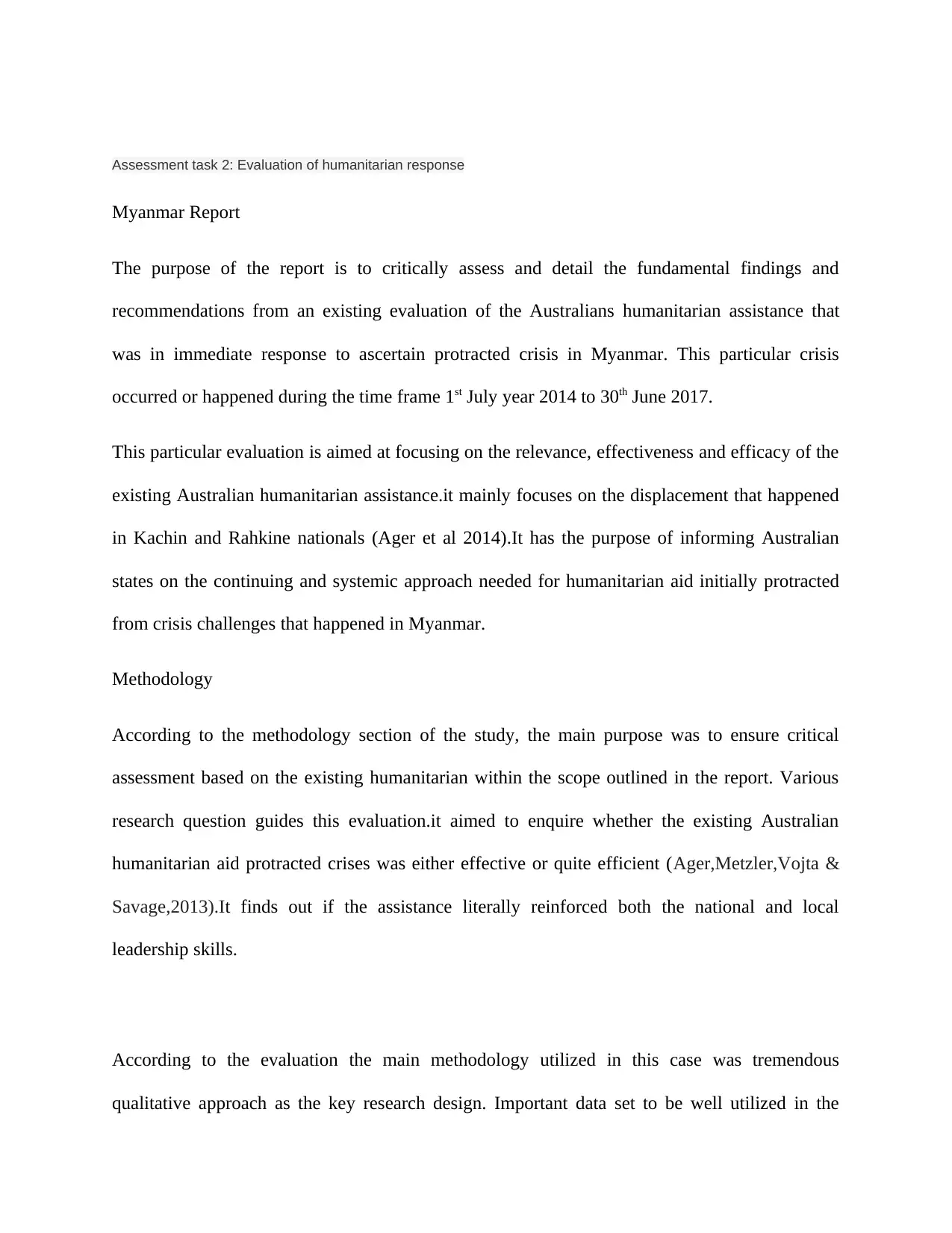
Assessment task 2: Evaluation of humanitarian response
Myanmar Report
The purpose of the report is to critically assess and detail the fundamental findings and
recommendations from an existing evaluation of the Australians humanitarian assistance that
was in immediate response to ascertain protracted crisis in Myanmar. This particular crisis
occurred or happened during the time frame 1st July year 2014 to 30th June 2017.
This particular evaluation is aimed at focusing on the relevance, effectiveness and efficacy of the
existing Australian humanitarian assistance.it mainly focuses on the displacement that happened
in Kachin and Rahkine nationals (Ager et al 2014).It has the purpose of informing Australian
states on the continuing and systemic approach needed for humanitarian aid initially protracted
from crisis challenges that happened in Myanmar.
Methodology
According to the methodology section of the study, the main purpose was to ensure critical
assessment based on the existing humanitarian within the scope outlined in the report. Various
research question guides this evaluation.it aimed to enquire whether the existing Australian
humanitarian aid protracted crises was either effective or quite efficient (Ager,Metzler,Vojta &
Savage,2013).It finds out if the assistance literally reinforced both the national and local
leadership skills.
According to the evaluation the main methodology utilized in this case was tremendous
qualitative approach as the key research design. Important data set to be well utilized in the
Myanmar Report
The purpose of the report is to critically assess and detail the fundamental findings and
recommendations from an existing evaluation of the Australians humanitarian assistance that
was in immediate response to ascertain protracted crisis in Myanmar. This particular crisis
occurred or happened during the time frame 1st July year 2014 to 30th June 2017.
This particular evaluation is aimed at focusing on the relevance, effectiveness and efficacy of the
existing Australian humanitarian assistance.it mainly focuses on the displacement that happened
in Kachin and Rahkine nationals (Ager et al 2014).It has the purpose of informing Australian
states on the continuing and systemic approach needed for humanitarian aid initially protracted
from crisis challenges that happened in Myanmar.
Methodology
According to the methodology section of the study, the main purpose was to ensure critical
assessment based on the existing humanitarian within the scope outlined in the report. Various
research question guides this evaluation.it aimed to enquire whether the existing Australian
humanitarian aid protracted crises was either effective or quite efficient (Ager,Metzler,Vojta &
Savage,2013).It finds out if the assistance literally reinforced both the national and local
leadership skills.
According to the evaluation the main methodology utilized in this case was tremendous
qualitative approach as the key research design. Important data set to be well utilized in the
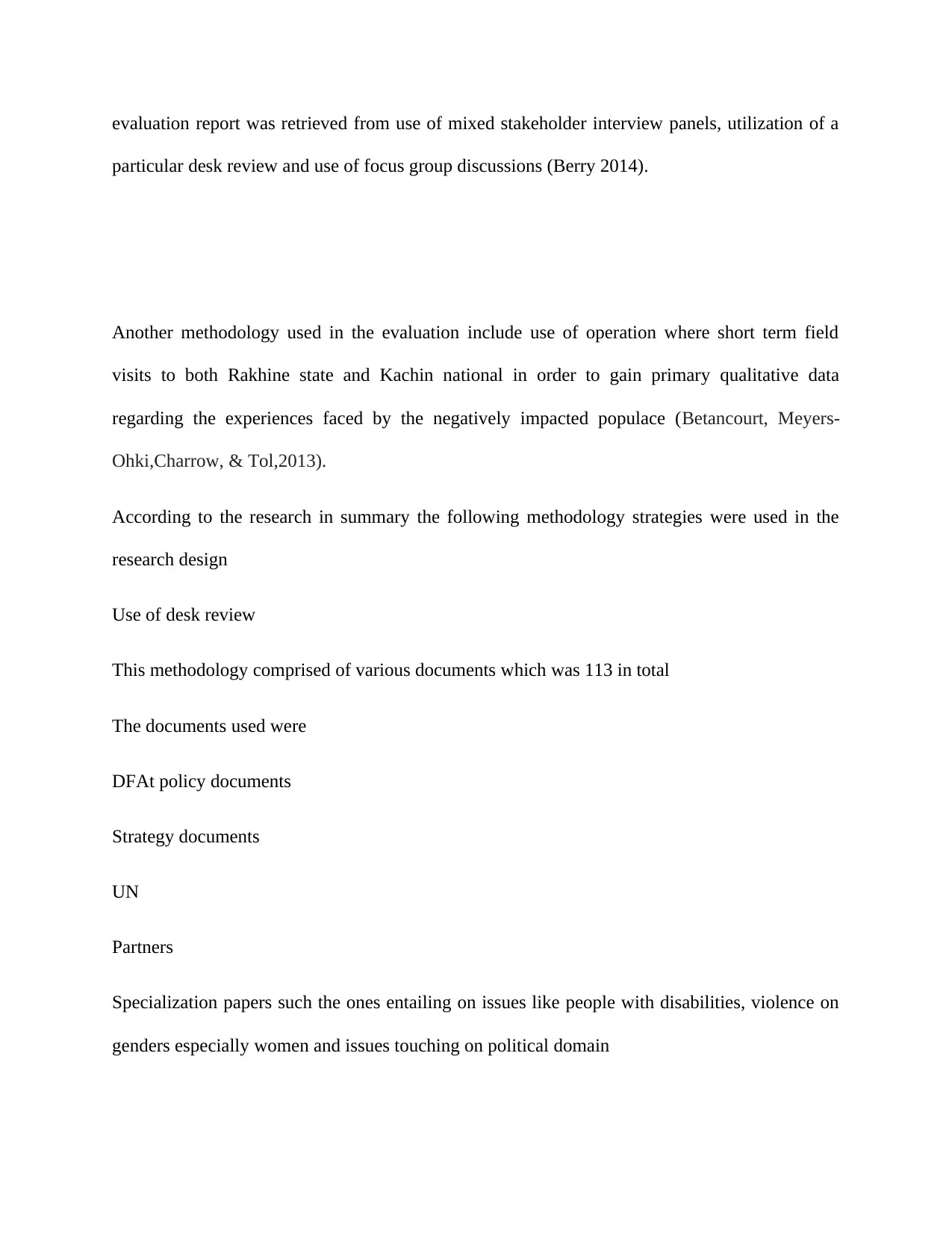
evaluation report was retrieved from use of mixed stakeholder interview panels, utilization of a
particular desk review and use of focus group discussions (Berry 2014).
Another methodology used in the evaluation include use of operation where short term field
visits to both Rakhine state and Kachin national in order to gain primary qualitative data
regarding the experiences faced by the negatively impacted populace (Betancourt, Meyers-
Ohki,Charrow, & Tol,2013).
According to the research in summary the following methodology strategies were used in the
research design
Use of desk review
This methodology comprised of various documents which was 113 in total
The documents used were
DFAt policy documents
Strategy documents
UN
Partners
Specialization papers such the ones entailing on issues like people with disabilities, violence on
genders especially women and issues touching on political domain
particular desk review and use of focus group discussions (Berry 2014).
Another methodology used in the evaluation include use of operation where short term field
visits to both Rakhine state and Kachin national in order to gain primary qualitative data
regarding the experiences faced by the negatively impacted populace (Betancourt, Meyers-
Ohki,Charrow, & Tol,2013).
According to the research in summary the following methodology strategies were used in the
research design
Use of desk review
This methodology comprised of various documents which was 113 in total
The documents used were
DFAt policy documents
Strategy documents
UN
Partners
Specialization papers such the ones entailing on issues like people with disabilities, violence on
genders especially women and issues touching on political domain
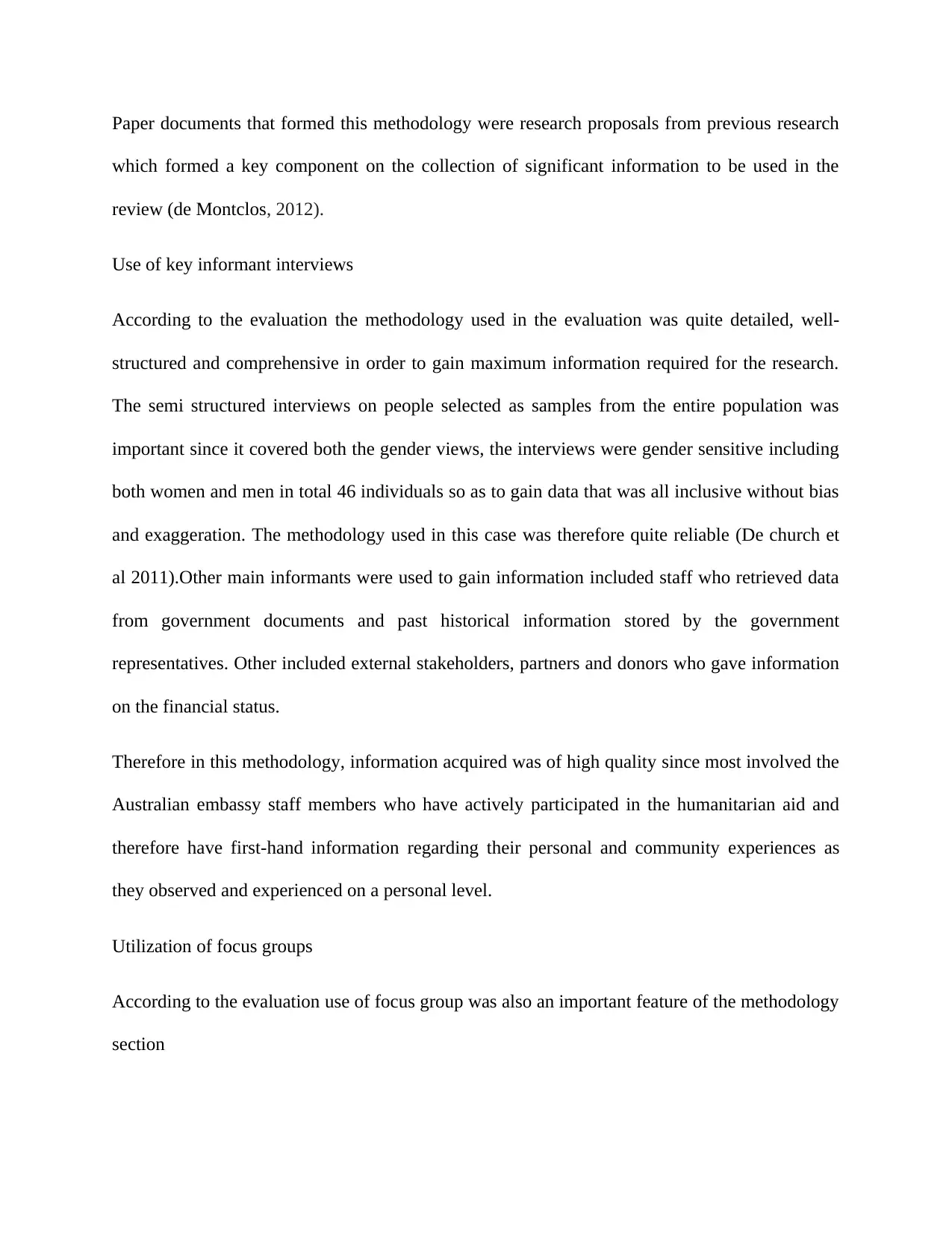
Paper documents that formed this methodology were research proposals from previous research
which formed a key component on the collection of significant information to be used in the
review (de Montclos, 2012).
Use of key informant interviews
According to the evaluation the methodology used in the evaluation was quite detailed, well-
structured and comprehensive in order to gain maximum information required for the research.
The semi structured interviews on people selected as samples from the entire population was
important since it covered both the gender views, the interviews were gender sensitive including
both women and men in total 46 individuals so as to gain data that was all inclusive without bias
and exaggeration. The methodology used in this case was therefore quite reliable (De church et
al 2011).Other main informants were used to gain information included staff who retrieved data
from government documents and past historical information stored by the government
representatives. Other included external stakeholders, partners and donors who gave information
on the financial status.
Therefore in this methodology, information acquired was of high quality since most involved the
Australian embassy staff members who have actively participated in the humanitarian aid and
therefore have first-hand information regarding their personal and community experiences as
they observed and experienced on a personal level.
Utilization of focus groups
According to the evaluation use of focus group was also an important feature of the methodology
section
which formed a key component on the collection of significant information to be used in the
review (de Montclos, 2012).
Use of key informant interviews
According to the evaluation the methodology used in the evaluation was quite detailed, well-
structured and comprehensive in order to gain maximum information required for the research.
The semi structured interviews on people selected as samples from the entire population was
important since it covered both the gender views, the interviews were gender sensitive including
both women and men in total 46 individuals so as to gain data that was all inclusive without bias
and exaggeration. The methodology used in this case was therefore quite reliable (De church et
al 2011).Other main informants were used to gain information included staff who retrieved data
from government documents and past historical information stored by the government
representatives. Other included external stakeholders, partners and donors who gave information
on the financial status.
Therefore in this methodology, information acquired was of high quality since most involved the
Australian embassy staff members who have actively participated in the humanitarian aid and
therefore have first-hand information regarding their personal and community experiences as
they observed and experienced on a personal level.
Utilization of focus groups
According to the evaluation use of focus group was also an important feature of the methodology
section
Secure Best Marks with AI Grader
Need help grading? Try our AI Grader for instant feedback on your assignments.
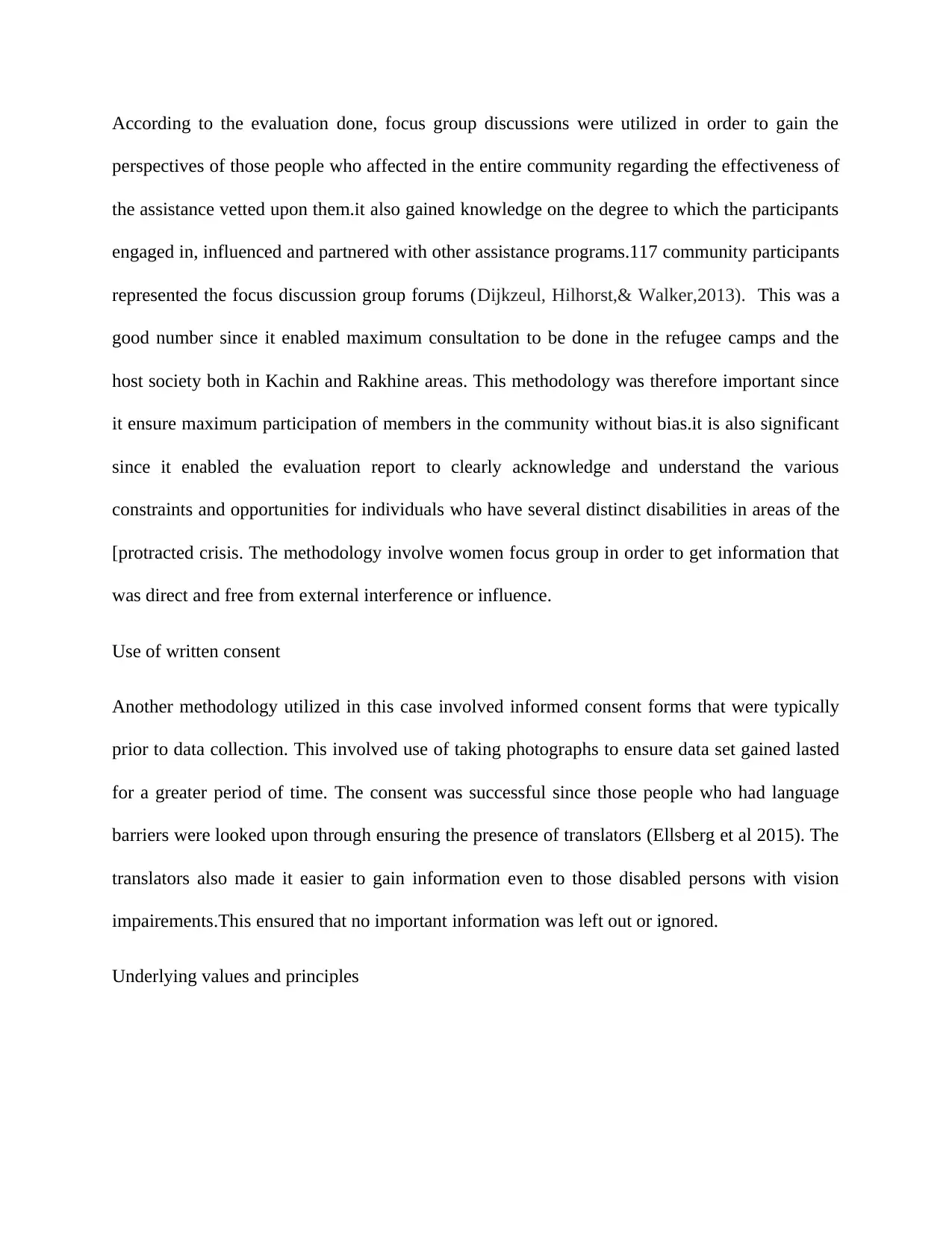
According to the evaluation done, focus group discussions were utilized in order to gain the
perspectives of those people who affected in the entire community regarding the effectiveness of
the assistance vetted upon them.it also gained knowledge on the degree to which the participants
engaged in, influenced and partnered with other assistance programs.117 community participants
represented the focus discussion group forums (Dijkzeul, Hilhorst,& Walker,2013). This was a
good number since it enabled maximum consultation to be done in the refugee camps and the
host society both in Kachin and Rakhine areas. This methodology was therefore important since
it ensure maximum participation of members in the community without bias.it is also significant
since it enabled the evaluation report to clearly acknowledge and understand the various
constraints and opportunities for individuals who have several distinct disabilities in areas of the
[protracted crisis. The methodology involve women focus group in order to get information that
was direct and free from external interference or influence.
Use of written consent
Another methodology utilized in this case involved informed consent forms that were typically
prior to data collection. This involved use of taking photographs to ensure data set gained lasted
for a greater period of time. The consent was successful since those people who had language
barriers were looked upon through ensuring the presence of translators (Ellsberg et al 2015). The
translators also made it easier to gain information even to those disabled persons with vision
impairements.This ensured that no important information was left out or ignored.
Underlying values and principles
perspectives of those people who affected in the entire community regarding the effectiveness of
the assistance vetted upon them.it also gained knowledge on the degree to which the participants
engaged in, influenced and partnered with other assistance programs.117 community participants
represented the focus discussion group forums (Dijkzeul, Hilhorst,& Walker,2013). This was a
good number since it enabled maximum consultation to be done in the refugee camps and the
host society both in Kachin and Rakhine areas. This methodology was therefore important since
it ensure maximum participation of members in the community without bias.it is also significant
since it enabled the evaluation report to clearly acknowledge and understand the various
constraints and opportunities for individuals who have several distinct disabilities in areas of the
[protracted crisis. The methodology involve women focus group in order to get information that
was direct and free from external interference or influence.
Use of written consent
Another methodology utilized in this case involved informed consent forms that were typically
prior to data collection. This involved use of taking photographs to ensure data set gained lasted
for a greater period of time. The consent was successful since those people who had language
barriers were looked upon through ensuring the presence of translators (Ellsberg et al 2015). The
translators also made it easier to gain information even to those disabled persons with vision
impairements.This ensured that no important information was left out or ignored.
Underlying values and principles
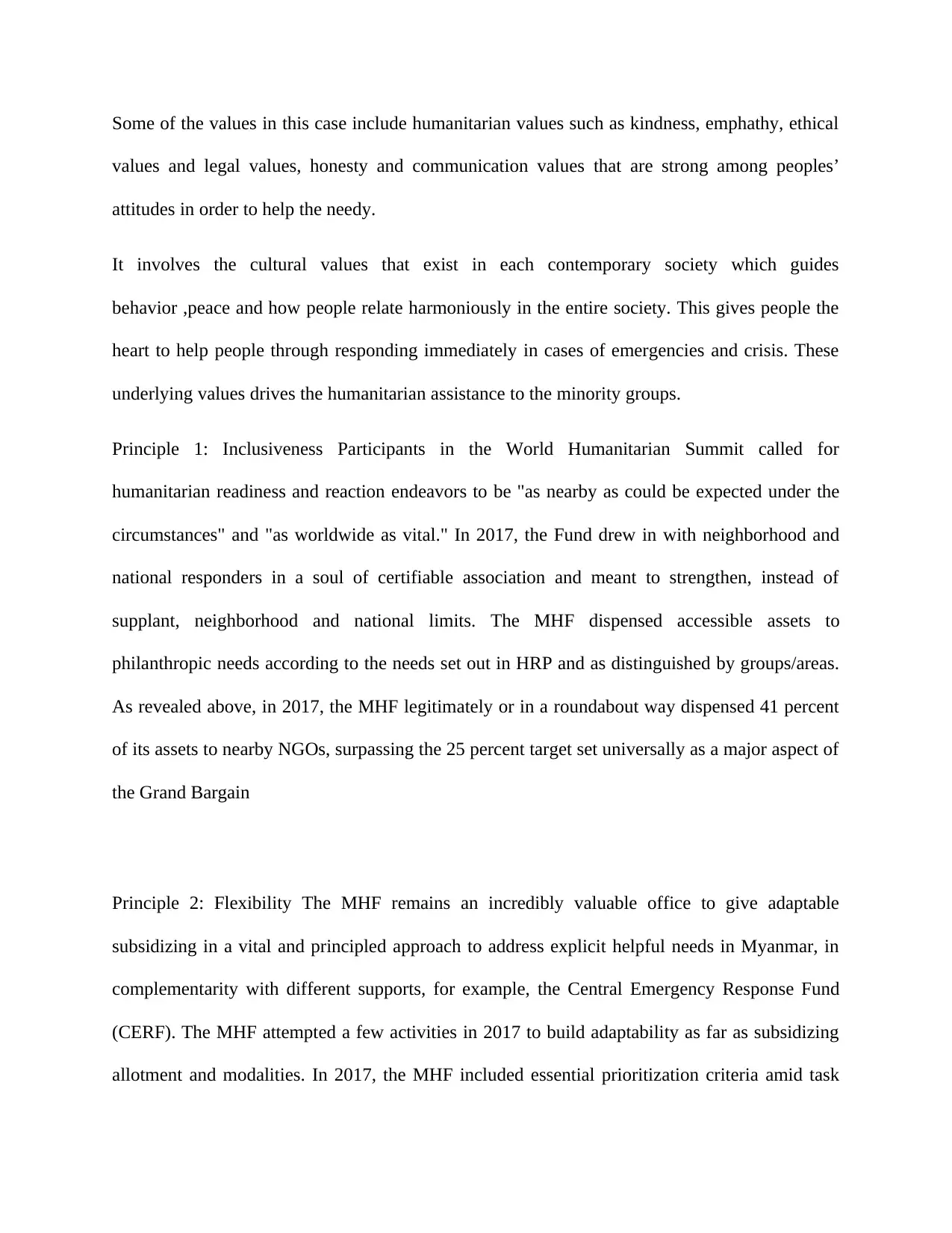
Some of the values in this case include humanitarian values such as kindness, emphathy, ethical
values and legal values, honesty and communication values that are strong among peoples’
attitudes in order to help the needy.
It involves the cultural values that exist in each contemporary society which guides
behavior ,peace and how people relate harmoniously in the entire society. This gives people the
heart to help people through responding immediately in cases of emergencies and crisis. These
underlying values drives the humanitarian assistance to the minority groups.
Principle 1: Inclusiveness Participants in the World Humanitarian Summit called for
humanitarian readiness and reaction endeavors to be "as nearby as could be expected under the
circumstances" and "as worldwide as vital." In 2017, the Fund drew in with neighborhood and
national responders in a soul of certifiable association and meant to strengthen, instead of
supplant, neighborhood and national limits. The MHF dispensed accessible assets to
philanthropic needs according to the needs set out in HRP and as distinguished by groups/areas.
As revealed above, in 2017, the MHF legitimately or in a roundabout way dispensed 41 percent
of its assets to nearby NGOs, surpassing the 25 percent target set universally as a major aspect of
the Grand Bargain
Principle 2: Flexibility The MHF remains an incredibly valuable office to give adaptable
subsidizing in a vital and principled approach to address explicit helpful needs in Myanmar, in
complementarity with different supports, for example, the Central Emergency Response Fund
(CERF). The MHF attempted a few activities in 2017 to build adaptability as far as subsidizing
allotment and modalities. In 2017, the MHF included essential prioritization criteria amid task
values and legal values, honesty and communication values that are strong among peoples’
attitudes in order to help the needy.
It involves the cultural values that exist in each contemporary society which guides
behavior ,peace and how people relate harmoniously in the entire society. This gives people the
heart to help people through responding immediately in cases of emergencies and crisis. These
underlying values drives the humanitarian assistance to the minority groups.
Principle 1: Inclusiveness Participants in the World Humanitarian Summit called for
humanitarian readiness and reaction endeavors to be "as nearby as could be expected under the
circumstances" and "as worldwide as vital." In 2017, the Fund drew in with neighborhood and
national responders in a soul of certifiable association and meant to strengthen, instead of
supplant, neighborhood and national limits. The MHF dispensed accessible assets to
philanthropic needs according to the needs set out in HRP and as distinguished by groups/areas.
As revealed above, in 2017, the MHF legitimately or in a roundabout way dispensed 41 percent
of its assets to nearby NGOs, surpassing the 25 percent target set universally as a major aspect of
the Grand Bargain
Principle 2: Flexibility The MHF remains an incredibly valuable office to give adaptable
subsidizing in a vital and principled approach to address explicit helpful needs in Myanmar, in
complementarity with different supports, for example, the Central Emergency Response Fund
(CERF). The MHF attempted a few activities in 2017 to build adaptability as far as subsidizing
allotment and modalities. In 2017, the MHF included essential prioritization criteria amid task
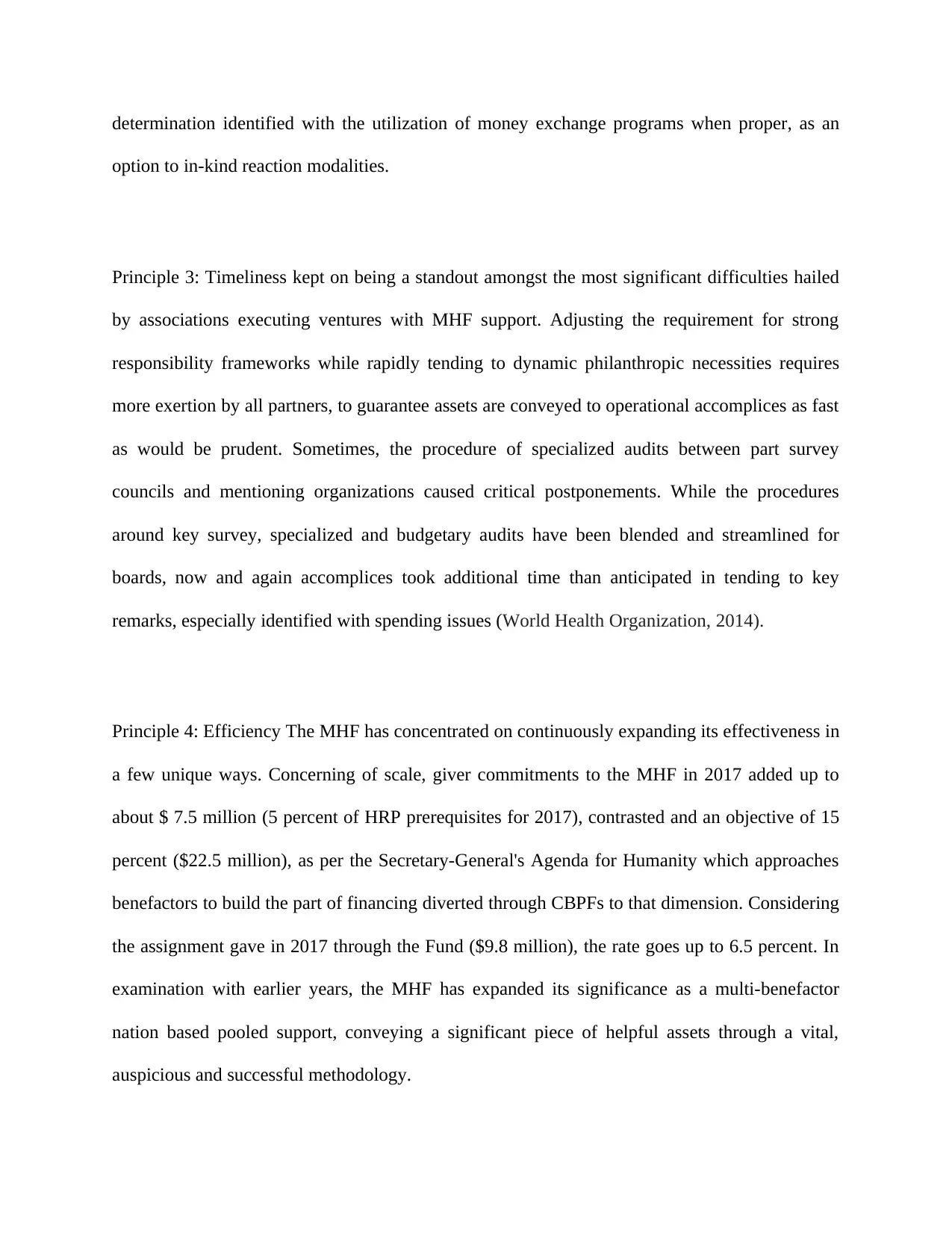
determination identified with the utilization of money exchange programs when proper, as an
option to in-kind reaction modalities.
Principle 3: Timeliness kept on being a standout amongst the most significant difficulties hailed
by associations executing ventures with MHF support. Adjusting the requirement for strong
responsibility frameworks while rapidly tending to dynamic philanthropic necessities requires
more exertion by all partners, to guarantee assets are conveyed to operational accomplices as fast
as would be prudent. Sometimes, the procedure of specialized audits between part survey
councils and mentioning organizations caused critical postponements. While the procedures
around key survey, specialized and budgetary audits have been blended and streamlined for
boards, now and again accomplices took additional time than anticipated in tending to key
remarks, especially identified with spending issues (World Health Organization, 2014).
Principle 4: Efficiency The MHF has concentrated on continuously expanding its effectiveness in
a few unique ways. Concerning of scale, giver commitments to the MHF in 2017 added up to
about $ 7.5 million (5 percent of HRP prerequisites for 2017), contrasted and an objective of 15
percent ($22.5 million), as per the Secretary-General's Agenda for Humanity which approaches
benefactors to build the part of financing diverted through CBPFs to that dimension. Considering
the assignment gave in 2017 through the Fund ($9.8 million), the rate goes up to 6.5 percent. In
examination with earlier years, the MHF has expanded its significance as a multi-benefactor
nation based pooled support, conveying a significant piece of helpful assets through a vital,
auspicious and successful methodology.
option to in-kind reaction modalities.
Principle 3: Timeliness kept on being a standout amongst the most significant difficulties hailed
by associations executing ventures with MHF support. Adjusting the requirement for strong
responsibility frameworks while rapidly tending to dynamic philanthropic necessities requires
more exertion by all partners, to guarantee assets are conveyed to operational accomplices as fast
as would be prudent. Sometimes, the procedure of specialized audits between part survey
councils and mentioning organizations caused critical postponements. While the procedures
around key survey, specialized and budgetary audits have been blended and streamlined for
boards, now and again accomplices took additional time than anticipated in tending to key
remarks, especially identified with spending issues (World Health Organization, 2014).
Principle 4: Efficiency The MHF has concentrated on continuously expanding its effectiveness in
a few unique ways. Concerning of scale, giver commitments to the MHF in 2017 added up to
about $ 7.5 million (5 percent of HRP prerequisites for 2017), contrasted and an objective of 15
percent ($22.5 million), as per the Secretary-General's Agenda for Humanity which approaches
benefactors to build the part of financing diverted through CBPFs to that dimension. Considering
the assignment gave in 2017 through the Fund ($9.8 million), the rate goes up to 6.5 percent. In
examination with earlier years, the MHF has expanded its significance as a multi-benefactor
nation based pooled support, conveying a significant piece of helpful assets through a vital,
auspicious and successful methodology.
Paraphrase This Document
Need a fresh take? Get an instant paraphrase of this document with our AI Paraphraser
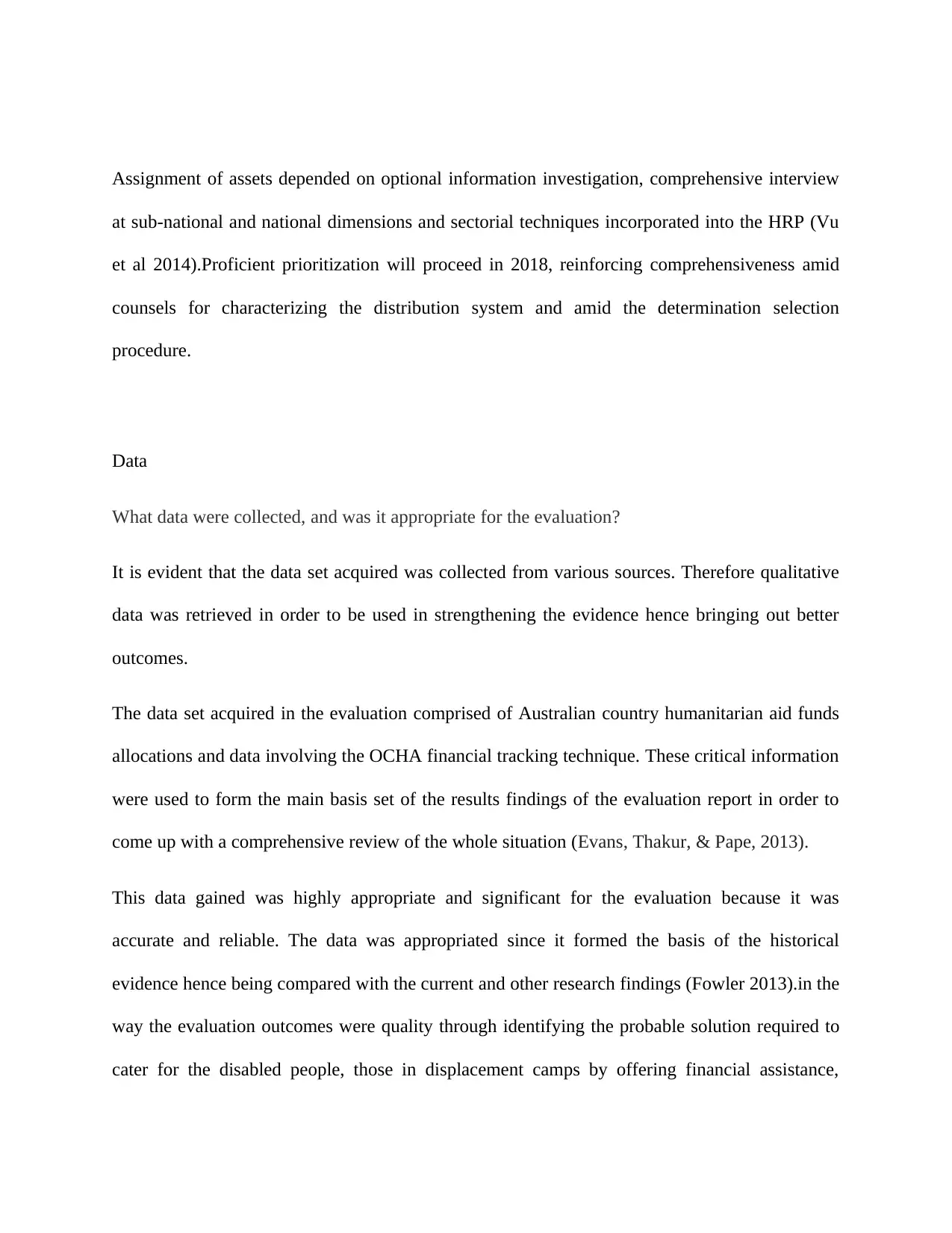
Assignment of assets depended on optional information investigation, comprehensive interview
at sub-national and national dimensions and sectorial techniques incorporated into the HRP (Vu
et al 2014).Proficient prioritization will proceed in 2018, reinforcing comprehensiveness amid
counsels for characterizing the distribution system and amid the determination selection
procedure.
Data
What data were collected, and was it appropriate for the evaluation?
It is evident that the data set acquired was collected from various sources. Therefore qualitative
data was retrieved in order to be used in strengthening the evidence hence bringing out better
outcomes.
The data set acquired in the evaluation comprised of Australian country humanitarian aid funds
allocations and data involving the OCHA financial tracking technique. These critical information
were used to form the main basis set of the results findings of the evaluation report in order to
come up with a comprehensive review of the whole situation (Evans, Thakur, & Pape, 2013).
This data gained was highly appropriate and significant for the evaluation because it was
accurate and reliable. The data was appropriated since it formed the basis of the historical
evidence hence being compared with the current and other research findings (Fowler 2013).in the
way the evaluation outcomes were quality through identifying the probable solution required to
cater for the disabled people, those in displacement camps by offering financial assistance,
at sub-national and national dimensions and sectorial techniques incorporated into the HRP (Vu
et al 2014).Proficient prioritization will proceed in 2018, reinforcing comprehensiveness amid
counsels for characterizing the distribution system and amid the determination selection
procedure.
Data
What data were collected, and was it appropriate for the evaluation?
It is evident that the data set acquired was collected from various sources. Therefore qualitative
data was retrieved in order to be used in strengthening the evidence hence bringing out better
outcomes.
The data set acquired in the evaluation comprised of Australian country humanitarian aid funds
allocations and data involving the OCHA financial tracking technique. These critical information
were used to form the main basis set of the results findings of the evaluation report in order to
come up with a comprehensive review of the whole situation (Evans, Thakur, & Pape, 2013).
This data gained was highly appropriate and significant for the evaluation because it was
accurate and reliable. The data was appropriated since it formed the basis of the historical
evidence hence being compared with the current and other research findings (Fowler 2013).in the
way the evaluation outcomes were quality through identifying the probable solution required to
cater for the disabled people, those in displacement camps by offering financial assistance,
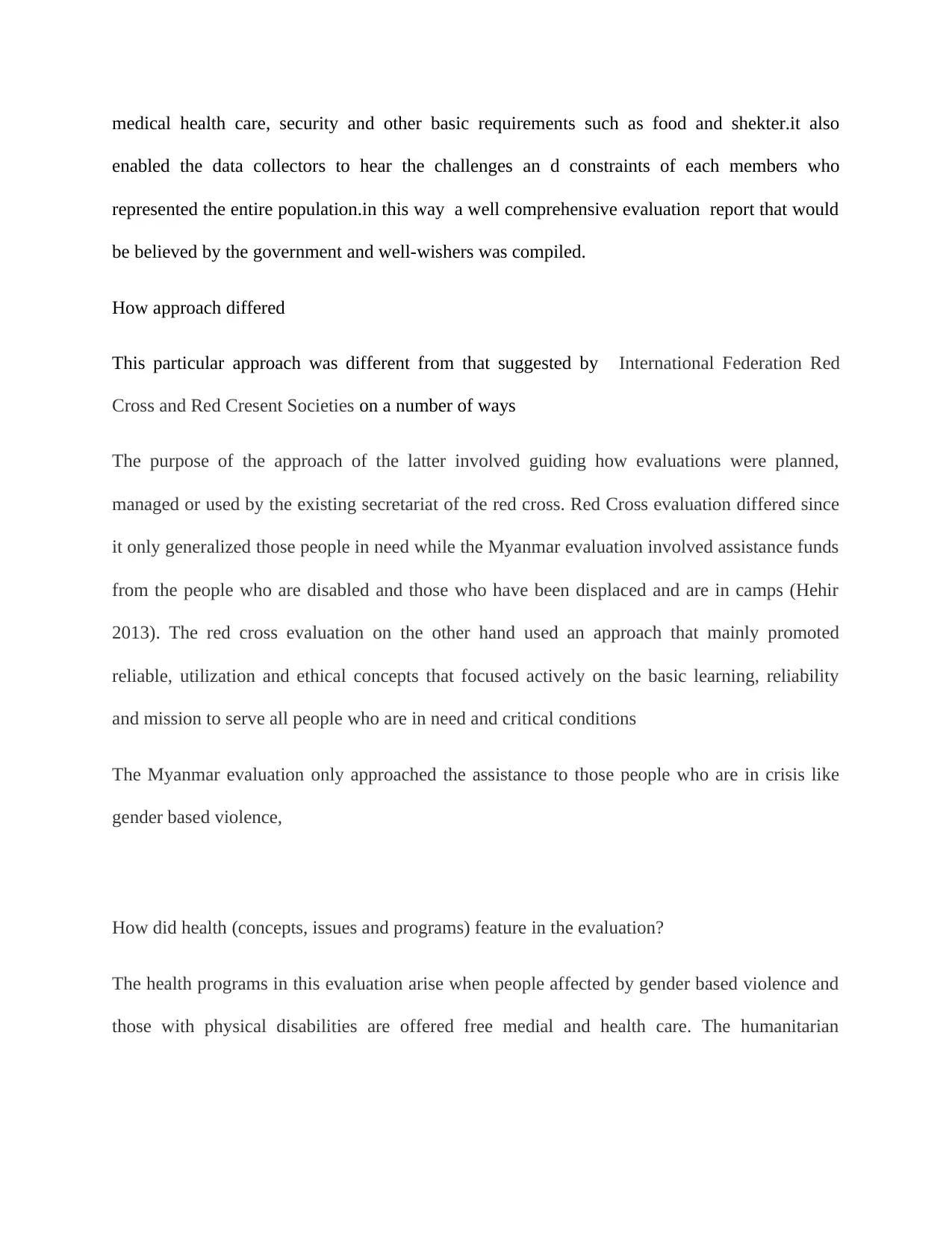
medical health care, security and other basic requirements such as food and shekter.it also
enabled the data collectors to hear the challenges an d constraints of each members who
represented the entire population.in this way a well comprehensive evaluation report that would
be believed by the government and well-wishers was compiled.
How approach differed
This particular approach was different from that suggested by International Federation Red
Cross and Red Cresent Societies on a number of ways
The purpose of the approach of the latter involved guiding how evaluations were planned,
managed or used by the existing secretariat of the red cross. Red Cross evaluation differed since
it only generalized those people in need while the Myanmar evaluation involved assistance funds
from the people who are disabled and those who have been displaced and are in camps (Hehir
2013). The red cross evaluation on the other hand used an approach that mainly promoted
reliable, utilization and ethical concepts that focused actively on the basic learning, reliability
and mission to serve all people who are in need and critical conditions
The Myanmar evaluation only approached the assistance to those people who are in crisis like
gender based violence,
How did health (concepts, issues and programs) feature in the evaluation?
The health programs in this evaluation arise when people affected by gender based violence and
those with physical disabilities are offered free medial and health care. The humanitarian
enabled the data collectors to hear the challenges an d constraints of each members who
represented the entire population.in this way a well comprehensive evaluation report that would
be believed by the government and well-wishers was compiled.
How approach differed
This particular approach was different from that suggested by International Federation Red
Cross and Red Cresent Societies on a number of ways
The purpose of the approach of the latter involved guiding how evaluations were planned,
managed or used by the existing secretariat of the red cross. Red Cross evaluation differed since
it only generalized those people in need while the Myanmar evaluation involved assistance funds
from the people who are disabled and those who have been displaced and are in camps (Hehir
2013). The red cross evaluation on the other hand used an approach that mainly promoted
reliable, utilization and ethical concepts that focused actively on the basic learning, reliability
and mission to serve all people who are in need and critical conditions
The Myanmar evaluation only approached the assistance to those people who are in crisis like
gender based violence,
How did health (concepts, issues and programs) feature in the evaluation?
The health programs in this evaluation arise when people affected by gender based violence and
those with physical disabilities are offered free medial and health care. The humanitarian

assistance provides them with improved health care such as interventions and medicines in order
to help the ailing individuals with disabilities.
Findings
the findings are quite appropriate since they indicate how people in the society suffer in cases
such as during war, gender based violence and those individuals with disabilities. The findings
indicate that the people need humanitarian assistance as it is based on qualitative figures and
evidence. The record surveys MHF tasks and shows how the Fund was utilized deliberately to
address pressing humanitarian requirements of the most powerless individuals in 2017. It gives a
report on the administration and responsibility of the Fund, and a concise diagram of results by
bunch and area. I need to express my true thankfulness to the Fund's benefactors for their long-
standing organization and backing. In 2017, their commitments came to $7.6 million, adding to
the Fund's vestige from 2016. This solid duty empowered us to help 25 fundamental
philanthropic intercessions that planned to give 440,000 the help and security that they
frantically need (Holzgrefe 2013).
In 2017 the MHF was an essential empowering agent of compassionate reaction both in basic
minutes when financing was rare, and for basic segments that are regularly underfunded. These
portions tended to quick needs in northern Rakhine, new uprooting in Kachin and Shan, and
bolstered the reaction to tornado Mora (Krause 2014).Designations focused on both inside
dislodged individuals and host networks in clear linkage with the vital targets characterized by
to help the ailing individuals with disabilities.
Findings
the findings are quite appropriate since they indicate how people in the society suffer in cases
such as during war, gender based violence and those individuals with disabilities. The findings
indicate that the people need humanitarian assistance as it is based on qualitative figures and
evidence. The record surveys MHF tasks and shows how the Fund was utilized deliberately to
address pressing humanitarian requirements of the most powerless individuals in 2017. It gives a
report on the administration and responsibility of the Fund, and a concise diagram of results by
bunch and area. I need to express my true thankfulness to the Fund's benefactors for their long-
standing organization and backing. In 2017, their commitments came to $7.6 million, adding to
the Fund's vestige from 2016. This solid duty empowered us to help 25 fundamental
philanthropic intercessions that planned to give 440,000 the help and security that they
frantically need (Holzgrefe 2013).
In 2017 the MHF was an essential empowering agent of compassionate reaction both in basic
minutes when financing was rare, and for basic segments that are regularly underfunded. These
portions tended to quick needs in northern Rakhine, new uprooting in Kachin and Shan, and
bolstered the reaction to tornado Mora (Krause 2014).Designations focused on both inside
dislodged individuals and host networks in clear linkage with the vital targets characterized by
Secure Best Marks with AI Grader
Need help grading? Try our AI Grader for instant feedback on your assignments.

the HRP. Activities financed by the MHF depended on refreshed evaluations and were obviously
connected to Myanmar's humanitarian coordination systems
According the findings of the evaluation the additional value and relative points of interest of
the MHF kept on being shown in 2017, as the Fund bolstered reaction to various crises
contrasting in scale, nature and area. This included, for example, tending to the intense hunger of
emergency influenced kids in Rakhine State and giving mine hazard training exercises to
community networks influenced by the equipped clash in Kachin and Shan States. Joining
adaptability and vital concentration with its vigorous responsibility framework, the MHF upheld
aggregate prioritization, guaranteed convenient designation of rare assets, and eventually added
to a more grounded and better organized helpful reaction (Marinho, Casas, Claudia,& Leite,
2015). As parts of Myanmar keep on confronting extended helpful requirements and the
probability of catastrophic events is high, we will keep showing the Fund's additional incentive
in 2018. This will incorporate proceeding with our accentuation on direct help to implementers,
particularly nearby accomplices, and proceeding to help a vital and composed reaction
(Martiniuk, Manouchehrian, Negin, & Zwi, 2012).Comunities are glad that 41% of distributions
in 2017 went to national NGOs, surpassing the World Humanitarian Summit focus around there.
Today, the MHF stays a standout amongst the best methods for supporting philanthropic reaction
in Myanmar. As Humanitarian Coordinator, they are completely dedicated to guaranteeing that
we understand the maximum capacity of the MHF to help the general population of Myanmar in
reacting to philanthropic needs in 2018. In such manner, It will lead aggregate endeavors to
expand the measure of the reserve, to point being to bring $15 million up in new commitments in
2018 (Morrow, Mock, Papendieck, & Kocmich,2011). Officials anticipate working intimately
connected to Myanmar's humanitarian coordination systems
According the findings of the evaluation the additional value and relative points of interest of
the MHF kept on being shown in 2017, as the Fund bolstered reaction to various crises
contrasting in scale, nature and area. This included, for example, tending to the intense hunger of
emergency influenced kids in Rakhine State and giving mine hazard training exercises to
community networks influenced by the equipped clash in Kachin and Shan States. Joining
adaptability and vital concentration with its vigorous responsibility framework, the MHF upheld
aggregate prioritization, guaranteed convenient designation of rare assets, and eventually added
to a more grounded and better organized helpful reaction (Marinho, Casas, Claudia,& Leite,
2015). As parts of Myanmar keep on confronting extended helpful requirements and the
probability of catastrophic events is high, we will keep showing the Fund's additional incentive
in 2018. This will incorporate proceeding with our accentuation on direct help to implementers,
particularly nearby accomplices, and proceeding to help a vital and composed reaction
(Martiniuk, Manouchehrian, Negin, & Zwi, 2012).Comunities are glad that 41% of distributions
in 2017 went to national NGOs, surpassing the World Humanitarian Summit focus around there.
Today, the MHF stays a standout amongst the best methods for supporting philanthropic reaction
in Myanmar. As Humanitarian Coordinator, they are completely dedicated to guaranteeing that
we understand the maximum capacity of the MHF to help the general population of Myanmar in
reacting to philanthropic needs in 2018. In such manner, It will lead aggregate endeavors to
expand the measure of the reserve, to point being to bring $15 million up in new commitments in
2018 (Morrow, Mock, Papendieck, & Kocmich,2011). Officials anticipate working intimately

with benefactor governments to accomplish this and I depend on the proceeded with help of
national and worldwide accomplices to improve the utilization of the funds
Background
The MHF is a multi-benefactor nation based pooled finance (CBPF) set up in 2007 to help the
auspicious designation and dispensing of giver assets to address the most pressing humaniatrain
needs and help the most powerless individuals in Myanmar. Before 2015, the MHF was known
as the Myanmar Emergency Response Fund (ERF). Up to 2013, the Fund was known as the
Humanitarian Multi-Stakeholder Fund (HMSF). The MHF is a pivotal instrument to empower
opportune, facilitated and powerful philanthropic reaction in Myanmar (Rogstadius et al 2013). It
is recognized by its center, adaptability, the capacity to support reaction through focused
allotments and its commitment to reinforcing helpful coordination and empowering authority in
Myanmar.
How is the productive and responsible utilization of the MHF reserves guaranteed?
According to the appropriate findings of the evaluation this is accomplished ultimately through
pooling and alleviating the multi-layered dangers of helpful activities in Myanmar, the MHF has
kept up its similar preference as an instrument that empowers givers to channel supports paying
little mind to the nature, area or method of conveyance of reaction (Sandvik,Jumbert,Karlsrud, &
Kaufmann,2014). The hazard the executives is a segment of the MHF responsibility structure
which empowers the Humanitarian Coordinator to guarantee that (I) accomplices are conveying
planned automatic outcomes, (ii) the MHF is overseen dependably and as per the built up
national and worldwide accomplices to improve the utilization of the funds
Background
The MHF is a multi-benefactor nation based pooled finance (CBPF) set up in 2007 to help the
auspicious designation and dispensing of giver assets to address the most pressing humaniatrain
needs and help the most powerless individuals in Myanmar. Before 2015, the MHF was known
as the Myanmar Emergency Response Fund (ERF). Up to 2013, the Fund was known as the
Humanitarian Multi-Stakeholder Fund (HMSF). The MHF is a pivotal instrument to empower
opportune, facilitated and powerful philanthropic reaction in Myanmar (Rogstadius et al 2013). It
is recognized by its center, adaptability, the capacity to support reaction through focused
allotments and its commitment to reinforcing helpful coordination and empowering authority in
Myanmar.
How is the productive and responsible utilization of the MHF reserves guaranteed?
According to the appropriate findings of the evaluation this is accomplished ultimately through
pooling and alleviating the multi-layered dangers of helpful activities in Myanmar, the MHF has
kept up its similar preference as an instrument that empowers givers to channel supports paying
little mind to the nature, area or method of conveyance of reaction (Sandvik,Jumbert,Karlsrud, &
Kaufmann,2014). The hazard the executives is a segment of the MHF responsibility structure
which empowers the Humanitarian Coordinator to guarantee that (I) accomplices are conveying
planned automatic outcomes, (ii) the MHF is overseen dependably and as per the built up
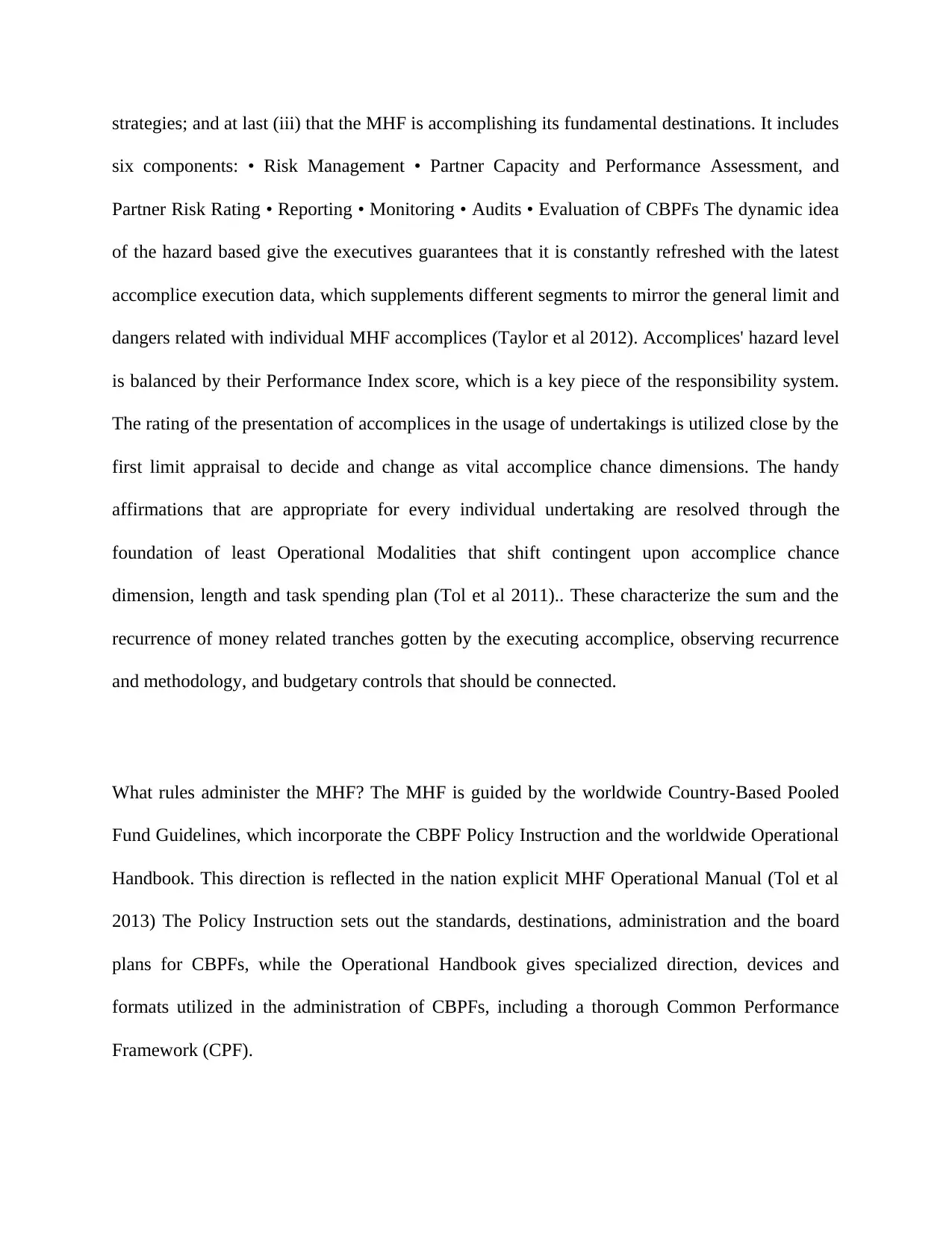
strategies; and at last (iii) that the MHF is accomplishing its fundamental destinations. It includes
six components: • Risk Management • Partner Capacity and Performance Assessment, and
Partner Risk Rating • Reporting • Monitoring • Audits • Evaluation of CBPFs The dynamic idea
of the hazard based give the executives guarantees that it is constantly refreshed with the latest
accomplice execution data, which supplements different segments to mirror the general limit and
dangers related with individual MHF accomplices (Taylor et al 2012). Accomplices' hazard level
is balanced by their Performance Index score, which is a key piece of the responsibility system.
The rating of the presentation of accomplices in the usage of undertakings is utilized close by the
first limit appraisal to decide and change as vital accomplice chance dimensions. The handy
affirmations that are appropriate for every individual undertaking are resolved through the
foundation of least Operational Modalities that shift contingent upon accomplice chance
dimension, length and task spending plan (Tol et al 2011).. These characterize the sum and the
recurrence of money related tranches gotten by the executing accomplice, observing recurrence
and methodology, and budgetary controls that should be connected.
What rules administer the MHF? The MHF is guided by the worldwide Country-Based Pooled
Fund Guidelines, which incorporate the CBPF Policy Instruction and the worldwide Operational
Handbook. This direction is reflected in the nation explicit MHF Operational Manual (Tol et al
2013) The Policy Instruction sets out the standards, destinations, administration and the board
plans for CBPFs, while the Operational Handbook gives specialized direction, devices and
formats utilized in the administration of CBPFs, including a thorough Common Performance
Framework (CPF).
six components: • Risk Management • Partner Capacity and Performance Assessment, and
Partner Risk Rating • Reporting • Monitoring • Audits • Evaluation of CBPFs The dynamic idea
of the hazard based give the executives guarantees that it is constantly refreshed with the latest
accomplice execution data, which supplements different segments to mirror the general limit and
dangers related with individual MHF accomplices (Taylor et al 2012). Accomplices' hazard level
is balanced by their Performance Index score, which is a key piece of the responsibility system.
The rating of the presentation of accomplices in the usage of undertakings is utilized close by the
first limit appraisal to decide and change as vital accomplice chance dimensions. The handy
affirmations that are appropriate for every individual undertaking are resolved through the
foundation of least Operational Modalities that shift contingent upon accomplice chance
dimension, length and task spending plan (Tol et al 2011).. These characterize the sum and the
recurrence of money related tranches gotten by the executing accomplice, observing recurrence
and methodology, and budgetary controls that should be connected.
What rules administer the MHF? The MHF is guided by the worldwide Country-Based Pooled
Fund Guidelines, which incorporate the CBPF Policy Instruction and the worldwide Operational
Handbook. This direction is reflected in the nation explicit MHF Operational Manual (Tol et al
2013) The Policy Instruction sets out the standards, destinations, administration and the board
plans for CBPFs, while the Operational Handbook gives specialized direction, devices and
formats utilized in the administration of CBPFs, including a thorough Common Performance
Framework (CPF).
Paraphrase This Document
Need a fresh take? Get an instant paraphrase of this document with our AI Paraphraser
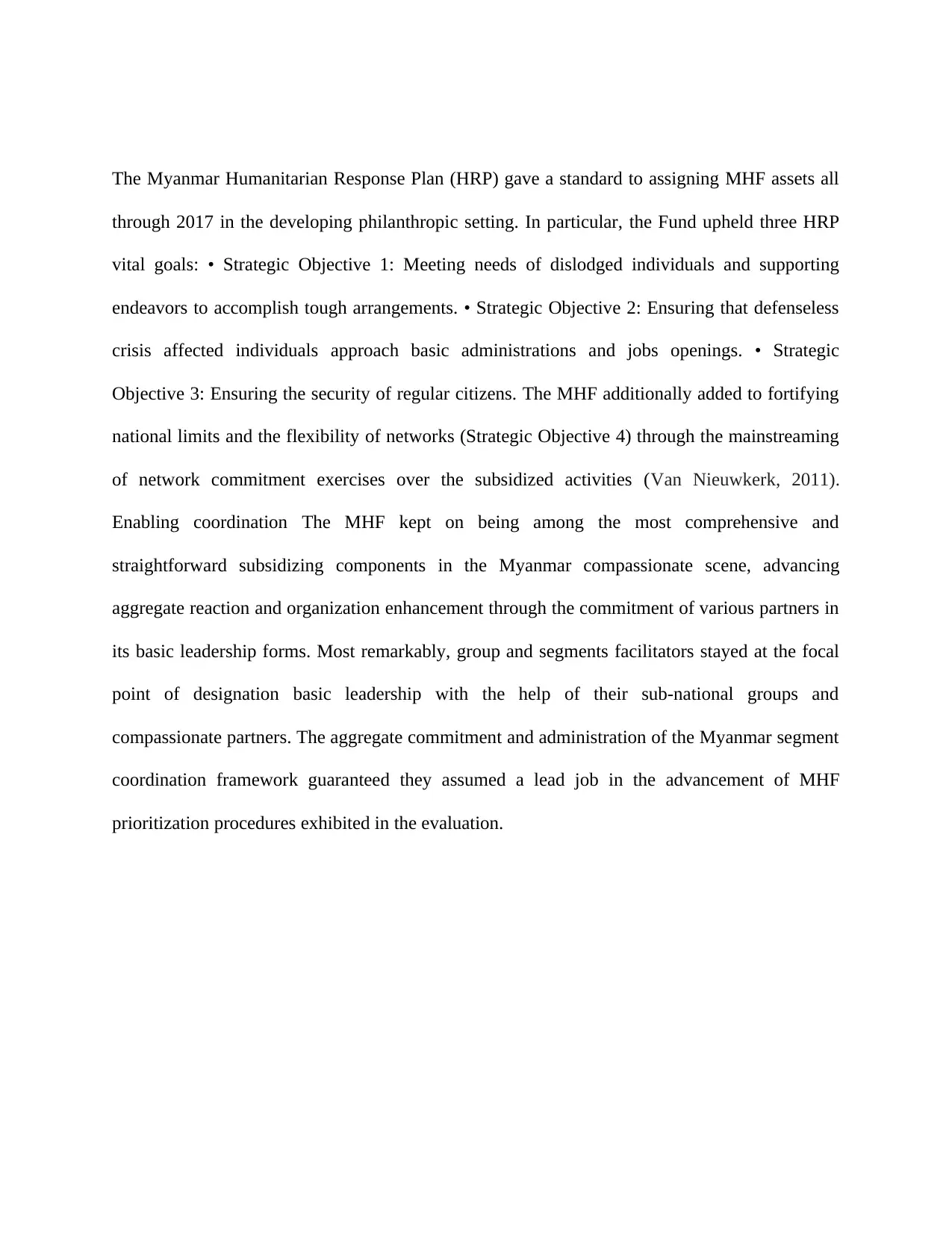
The Myanmar Humanitarian Response Plan (HRP) gave a standard to assigning MHF assets all
through 2017 in the developing philanthropic setting. In particular, the Fund upheld three HRP
vital goals: • Strategic Objective 1: Meeting needs of dislodged individuals and supporting
endeavors to accomplish tough arrangements. • Strategic Objective 2: Ensuring that defenseless
crisis affected individuals approach basic administrations and jobs openings. • Strategic
Objective 3: Ensuring the security of regular citizens. The MHF additionally added to fortifying
national limits and the flexibility of networks (Strategic Objective 4) through the mainstreaming
of network commitment exercises over the subsidized activities (Van Nieuwkerk, 2011).
Enabling coordination The MHF kept on being among the most comprehensive and
straightforward subsidizing components in the Myanmar compassionate scene, advancing
aggregate reaction and organization enhancement through the commitment of various partners in
its basic leadership forms. Most remarkably, group and segments facilitators stayed at the focal
point of designation basic leadership with the help of their sub-national groups and
compassionate partners. The aggregate commitment and administration of the Myanmar segment
coordination framework guaranteed they assumed a lead job in the advancement of MHF
prioritization procedures exhibited in the evaluation.
through 2017 in the developing philanthropic setting. In particular, the Fund upheld three HRP
vital goals: • Strategic Objective 1: Meeting needs of dislodged individuals and supporting
endeavors to accomplish tough arrangements. • Strategic Objective 2: Ensuring that defenseless
crisis affected individuals approach basic administrations and jobs openings. • Strategic
Objective 3: Ensuring the security of regular citizens. The MHF additionally added to fortifying
national limits and the flexibility of networks (Strategic Objective 4) through the mainstreaming
of network commitment exercises over the subsidized activities (Van Nieuwkerk, 2011).
Enabling coordination The MHF kept on being among the most comprehensive and
straightforward subsidizing components in the Myanmar compassionate scene, advancing
aggregate reaction and organization enhancement through the commitment of various partners in
its basic leadership forms. Most remarkably, group and segments facilitators stayed at the focal
point of designation basic leadership with the help of their sub-national groups and
compassionate partners. The aggregate commitment and administration of the Myanmar segment
coordination framework guaranteed they assumed a lead job in the advancement of MHF
prioritization procedures exhibited in the evaluation.
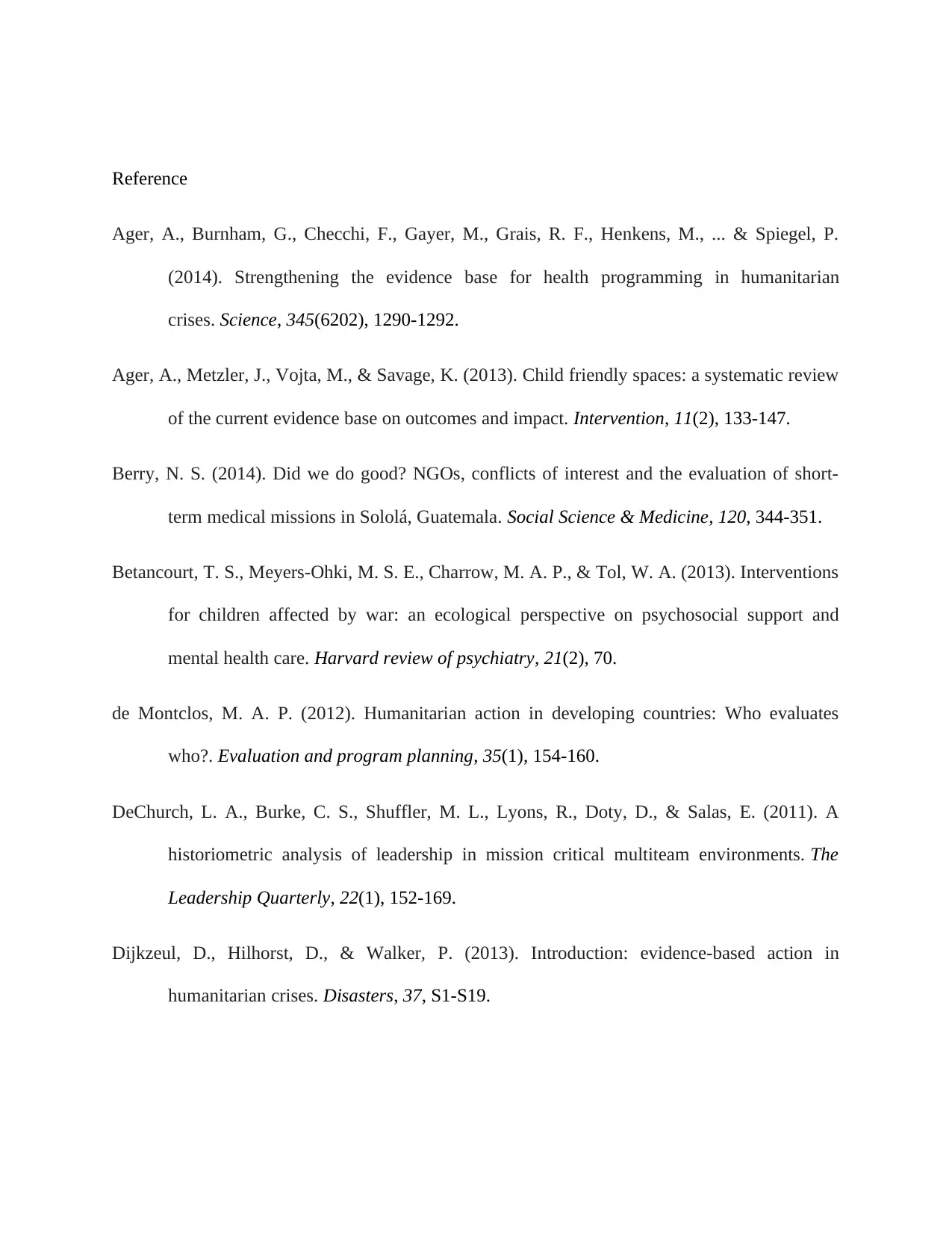
Reference
Ager, A., Burnham, G., Checchi, F., Gayer, M., Grais, R. F., Henkens, M., ... & Spiegel, P.
(2014). Strengthening the evidence base for health programming in humanitarian
crises. Science, 345(6202), 1290-1292.
Ager, A., Metzler, J., Vojta, M., & Savage, K. (2013). Child friendly spaces: a systematic review
of the current evidence base on outcomes and impact. Intervention, 11(2), 133-147.
Berry, N. S. (2014). Did we do good? NGOs, conflicts of interest and the evaluation of short-
term medical missions in Sololá, Guatemala. Social Science & Medicine, 120, 344-351.
Betancourt, T. S., Meyers-Ohki, M. S. E., Charrow, M. A. P., & Tol, W. A. (2013). Interventions
for children affected by war: an ecological perspective on psychosocial support and
mental health care. Harvard review of psychiatry, 21(2), 70.
de Montclos, M. A. P. (2012). Humanitarian action in developing countries: Who evaluates
who?. Evaluation and program planning, 35(1), 154-160.
DeChurch, L. A., Burke, C. S., Shuffler, M. L., Lyons, R., Doty, D., & Salas, E. (2011). A
historiometric analysis of leadership in mission critical multiteam environments. The
Leadership Quarterly, 22(1), 152-169.
Dijkzeul, D., Hilhorst, D., & Walker, P. (2013). Introduction: evidence‐based action in
humanitarian crises. Disasters, 37, S1-S19.
Ager, A., Burnham, G., Checchi, F., Gayer, M., Grais, R. F., Henkens, M., ... & Spiegel, P.
(2014). Strengthening the evidence base for health programming in humanitarian
crises. Science, 345(6202), 1290-1292.
Ager, A., Metzler, J., Vojta, M., & Savage, K. (2013). Child friendly spaces: a systematic review
of the current evidence base on outcomes and impact. Intervention, 11(2), 133-147.
Berry, N. S. (2014). Did we do good? NGOs, conflicts of interest and the evaluation of short-
term medical missions in Sololá, Guatemala. Social Science & Medicine, 120, 344-351.
Betancourt, T. S., Meyers-Ohki, M. S. E., Charrow, M. A. P., & Tol, W. A. (2013). Interventions
for children affected by war: an ecological perspective on psychosocial support and
mental health care. Harvard review of psychiatry, 21(2), 70.
de Montclos, M. A. P. (2012). Humanitarian action in developing countries: Who evaluates
who?. Evaluation and program planning, 35(1), 154-160.
DeChurch, L. A., Burke, C. S., Shuffler, M. L., Lyons, R., Doty, D., & Salas, E. (2011). A
historiometric analysis of leadership in mission critical multiteam environments. The
Leadership Quarterly, 22(1), 152-169.
Dijkzeul, D., Hilhorst, D., & Walker, P. (2013). Introduction: evidence‐based action in
humanitarian crises. Disasters, 37, S1-S19.
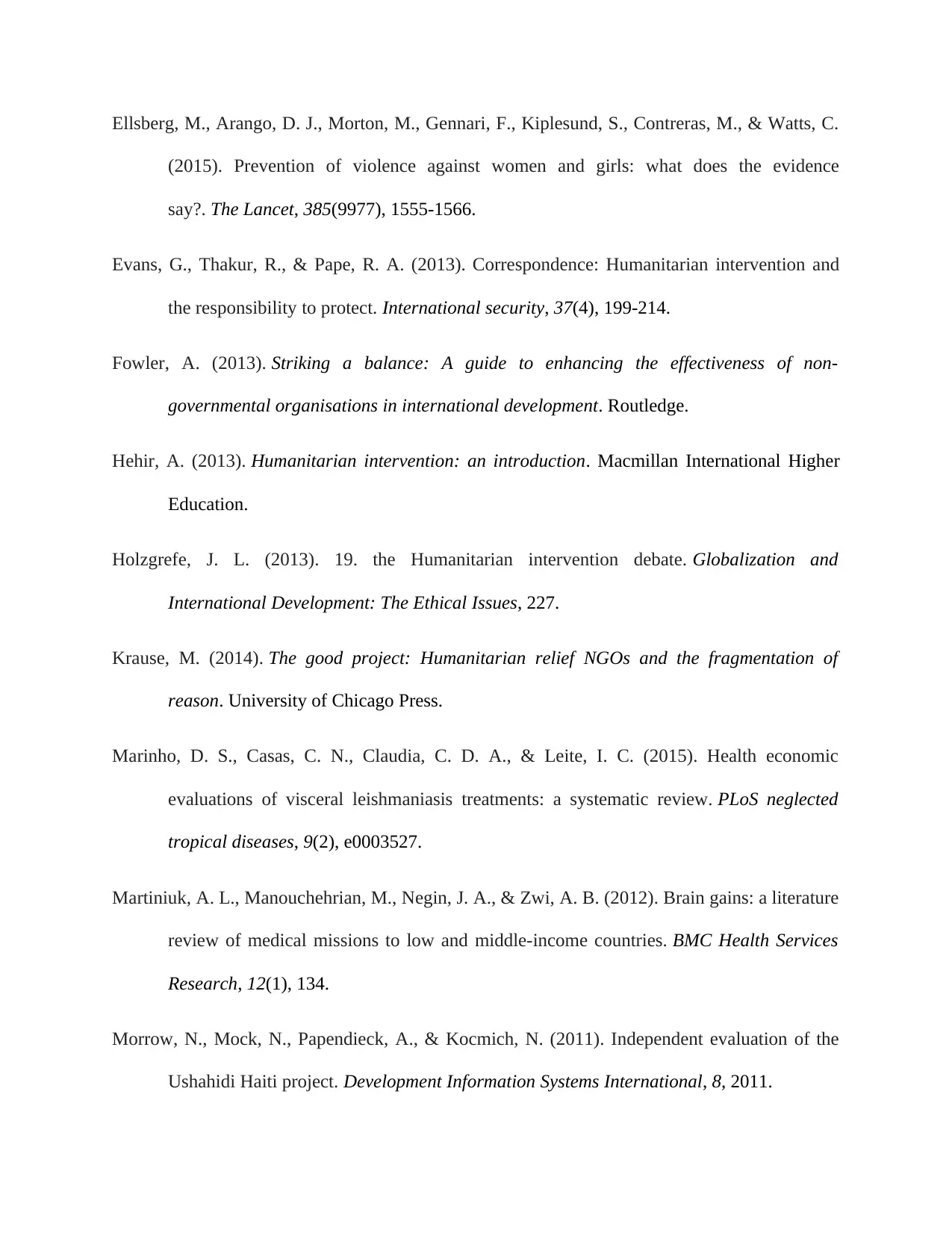
Ellsberg, M., Arango, D. J., Morton, M., Gennari, F., Kiplesund, S., Contreras, M., & Watts, C.
(2015). Prevention of violence against women and girls: what does the evidence
say?. The Lancet, 385(9977), 1555-1566.
Evans, G., Thakur, R., & Pape, R. A. (2013). Correspondence: Humanitarian intervention and
the responsibility to protect. International security, 37(4), 199-214.
Fowler, A. (2013). Striking a balance: A guide to enhancing the effectiveness of non-
governmental organisations in international development. Routledge.
Hehir, A. (2013). Humanitarian intervention: an introduction. Macmillan International Higher
Education.
Holzgrefe, J. L. (2013). 19. the Humanitarian intervention debate. Globalization and
International Development: The Ethical Issues, 227.
Krause, M. (2014). The good project: Humanitarian relief NGOs and the fragmentation of
reason. University of Chicago Press.
Marinho, D. S., Casas, C. N., Claudia, C. D. A., & Leite, I. C. (2015). Health economic
evaluations of visceral leishmaniasis treatments: a systematic review. PLoS neglected
tropical diseases, 9(2), e0003527.
Martiniuk, A. L., Manouchehrian, M., Negin, J. A., & Zwi, A. B. (2012). Brain gains: a literature
review of medical missions to low and middle-income countries. BMC Health Services
Research, 12(1), 134.
Morrow, N., Mock, N., Papendieck, A., & Kocmich, N. (2011). Independent evaluation of the
Ushahidi Haiti project. Development Information Systems International, 8, 2011.
(2015). Prevention of violence against women and girls: what does the evidence
say?. The Lancet, 385(9977), 1555-1566.
Evans, G., Thakur, R., & Pape, R. A. (2013). Correspondence: Humanitarian intervention and
the responsibility to protect. International security, 37(4), 199-214.
Fowler, A. (2013). Striking a balance: A guide to enhancing the effectiveness of non-
governmental organisations in international development. Routledge.
Hehir, A. (2013). Humanitarian intervention: an introduction. Macmillan International Higher
Education.
Holzgrefe, J. L. (2013). 19. the Humanitarian intervention debate. Globalization and
International Development: The Ethical Issues, 227.
Krause, M. (2014). The good project: Humanitarian relief NGOs and the fragmentation of
reason. University of Chicago Press.
Marinho, D. S., Casas, C. N., Claudia, C. D. A., & Leite, I. C. (2015). Health economic
evaluations of visceral leishmaniasis treatments: a systematic review. PLoS neglected
tropical diseases, 9(2), e0003527.
Martiniuk, A. L., Manouchehrian, M., Negin, J. A., & Zwi, A. B. (2012). Brain gains: a literature
review of medical missions to low and middle-income countries. BMC Health Services
Research, 12(1), 134.
Morrow, N., Mock, N., Papendieck, A., & Kocmich, N. (2011). Independent evaluation of the
Ushahidi Haiti project. Development Information Systems International, 8, 2011.
Secure Best Marks with AI Grader
Need help grading? Try our AI Grader for instant feedback on your assignments.
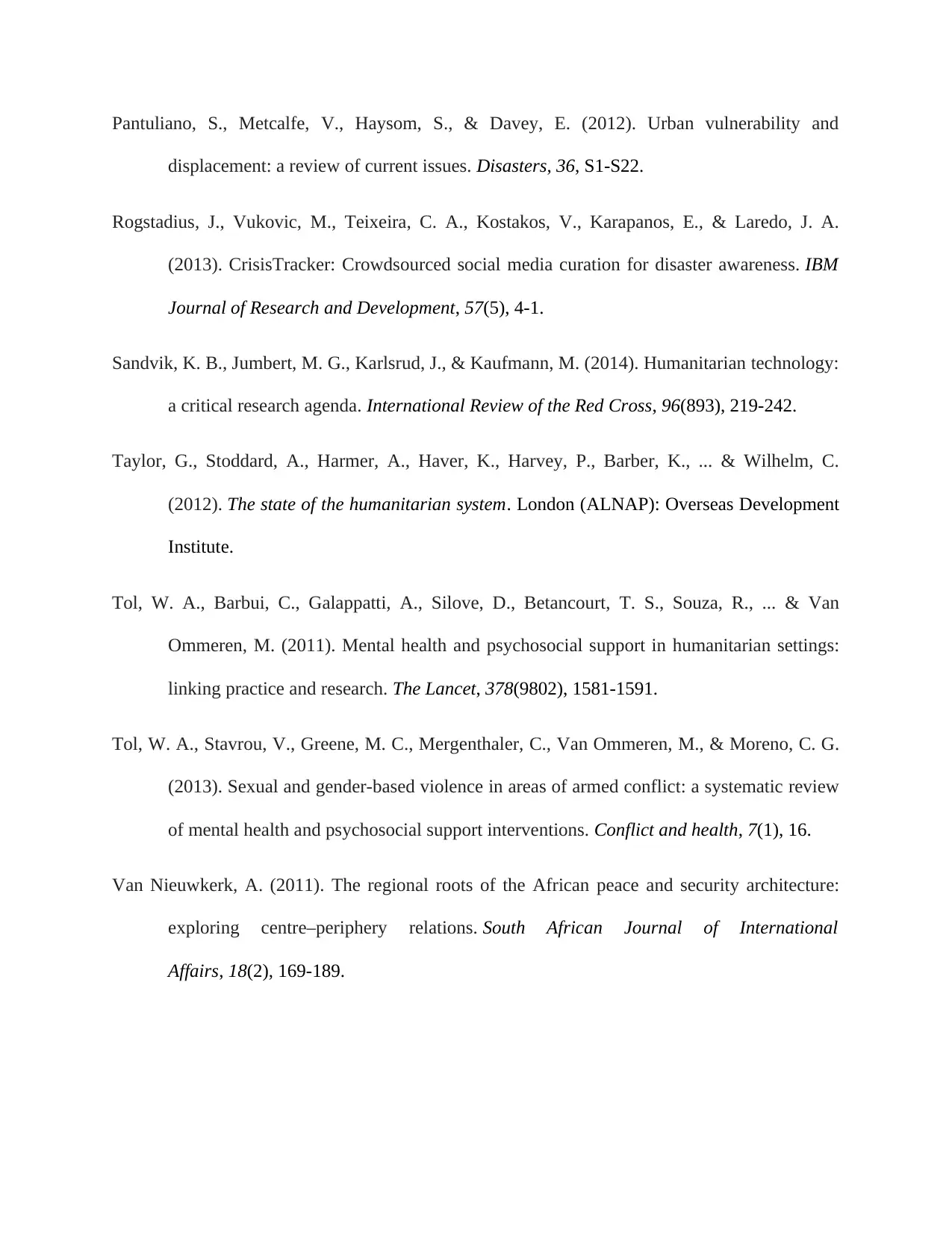
Pantuliano, S., Metcalfe, V., Haysom, S., & Davey, E. (2012). Urban vulnerability and
displacement: a review of current issues. Disasters, 36, S1-S22.
Rogstadius, J., Vukovic, M., Teixeira, C. A., Kostakos, V., Karapanos, E., & Laredo, J. A.
(2013). CrisisTracker: Crowdsourced social media curation for disaster awareness. IBM
Journal of Research and Development, 57(5), 4-1.
Sandvik, K. B., Jumbert, M. G., Karlsrud, J., & Kaufmann, M. (2014). Humanitarian technology:
a critical research agenda. International Review of the Red Cross, 96(893), 219-242.
Taylor, G., Stoddard, A., Harmer, A., Haver, K., Harvey, P., Barber, K., ... & Wilhelm, C.
(2012). The state of the humanitarian system. London (ALNAP): Overseas Development
Institute.
Tol, W. A., Barbui, C., Galappatti, A., Silove, D., Betancourt, T. S., Souza, R., ... & Van
Ommeren, M. (2011). Mental health and psychosocial support in humanitarian settings:
linking practice and research. The Lancet, 378(9802), 1581-1591.
Tol, W. A., Stavrou, V., Greene, M. C., Mergenthaler, C., Van Ommeren, M., & Moreno, C. G.
(2013). Sexual and gender-based violence in areas of armed conflict: a systematic review
of mental health and psychosocial support interventions. Conflict and health, 7(1), 16.
Van Nieuwkerk, A. (2011). The regional roots of the African peace and security architecture:
exploring centre–periphery relations. South African Journal of International
Affairs, 18(2), 169-189.
displacement: a review of current issues. Disasters, 36, S1-S22.
Rogstadius, J., Vukovic, M., Teixeira, C. A., Kostakos, V., Karapanos, E., & Laredo, J. A.
(2013). CrisisTracker: Crowdsourced social media curation for disaster awareness. IBM
Journal of Research and Development, 57(5), 4-1.
Sandvik, K. B., Jumbert, M. G., Karlsrud, J., & Kaufmann, M. (2014). Humanitarian technology:
a critical research agenda. International Review of the Red Cross, 96(893), 219-242.
Taylor, G., Stoddard, A., Harmer, A., Haver, K., Harvey, P., Barber, K., ... & Wilhelm, C.
(2012). The state of the humanitarian system. London (ALNAP): Overseas Development
Institute.
Tol, W. A., Barbui, C., Galappatti, A., Silove, D., Betancourt, T. S., Souza, R., ... & Van
Ommeren, M. (2011). Mental health and psychosocial support in humanitarian settings:
linking practice and research. The Lancet, 378(9802), 1581-1591.
Tol, W. A., Stavrou, V., Greene, M. C., Mergenthaler, C., Van Ommeren, M., & Moreno, C. G.
(2013). Sexual and gender-based violence in areas of armed conflict: a systematic review
of mental health and psychosocial support interventions. Conflict and health, 7(1), 16.
Van Nieuwkerk, A. (2011). The regional roots of the African peace and security architecture:
exploring centre–periphery relations. South African Journal of International
Affairs, 18(2), 169-189.
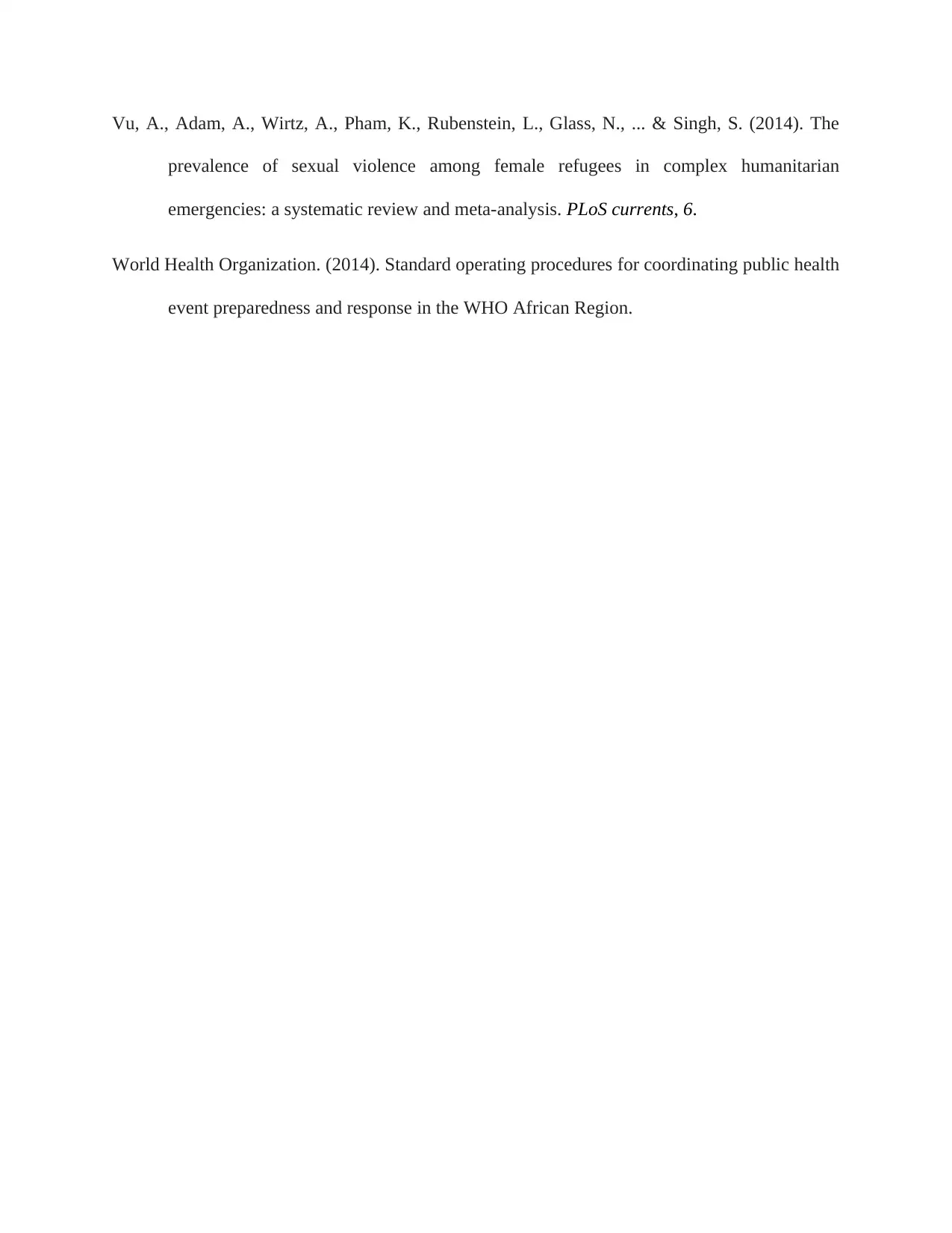
Vu, A., Adam, A., Wirtz, A., Pham, K., Rubenstein, L., Glass, N., ... & Singh, S. (2014). The
prevalence of sexual violence among female refugees in complex humanitarian
emergencies: a systematic review and meta-analysis. PLoS currents, 6.
World Health Organization. (2014). Standard operating procedures for coordinating public health
event preparedness and response in the WHO African Region.
prevalence of sexual violence among female refugees in complex humanitarian
emergencies: a systematic review and meta-analysis. PLoS currents, 6.
World Health Organization. (2014). Standard operating procedures for coordinating public health
event preparedness and response in the WHO African Region.
1 out of 18
Related Documents
Your All-in-One AI-Powered Toolkit for Academic Success.
+13062052269
info@desklib.com
Available 24*7 on WhatsApp / Email
![[object Object]](/_next/static/media/star-bottom.7253800d.svg)
Unlock your academic potential
© 2024 | Zucol Services PVT LTD | All rights reserved.





